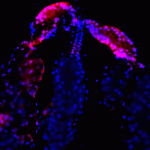Link to Pubmed [PMID] – 27099625
Evol Appl 2016 Apr;9(4):608-18
Despite their epidemiological importance, the evolutionary forces that shape the spatial structure of dengue virus genetic diversity are not fully understood. Fine-scale genetic structure of mosquito vector populations and evidence for genotype × genotype interactions between dengue viruses and their mosquito vectors are consistent with the hypothesis that the geographical distribution of dengue virus genetic diversity may reflect viral adaptation to local mosquito populations. To test this hypothesis, we measured vector competence in all sympatric and allopatric combinations of 14 low-passage dengue virus isolates and two wild-type populations of Aedes aegypti mosquitoes sampled in Bangkok and Kamphaeng Phet, two sites located about 300 km apart in Thailand. Despite significant genotype × genotype interactions, we found no evidence for superior vector competence in sympatric versus allopatric vector-virus combinations. Viral phylogenetic analysis revealed no geographical clustering of the 14 isolates, suggesting that high levels of viral migration (gene flow) in Thailand may counteract spatially heterogeneous natural selection. We conclude that it is unlikely that vector-mediated selection is a major driver of dengue virus adaptive evolution at the regional scale that we examined. Dengue virus local adaptation to mosquito vector populations could happen, however, in places or times that we did not test, or at a different geographical scale.

